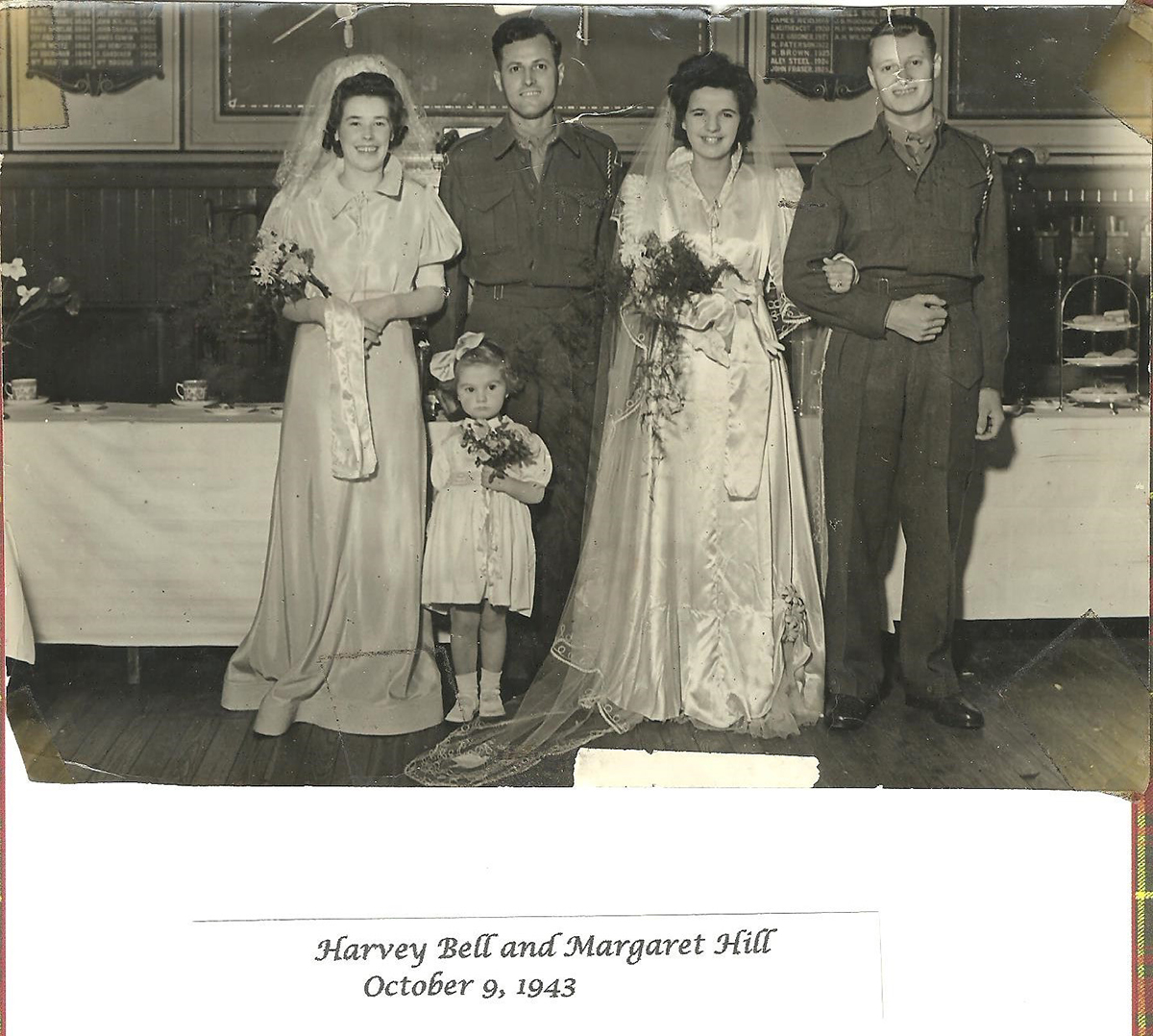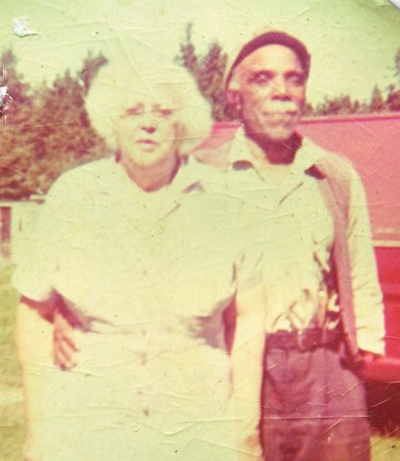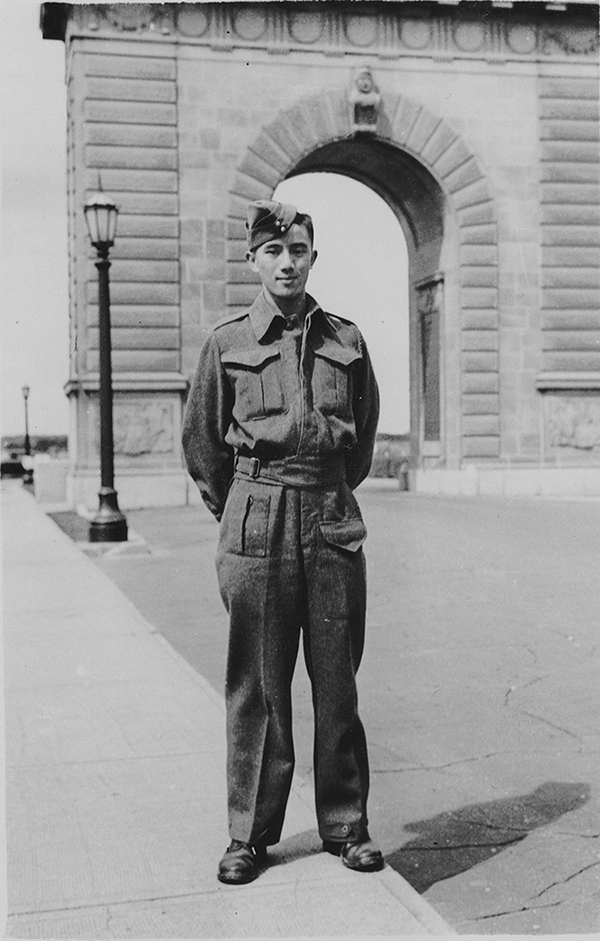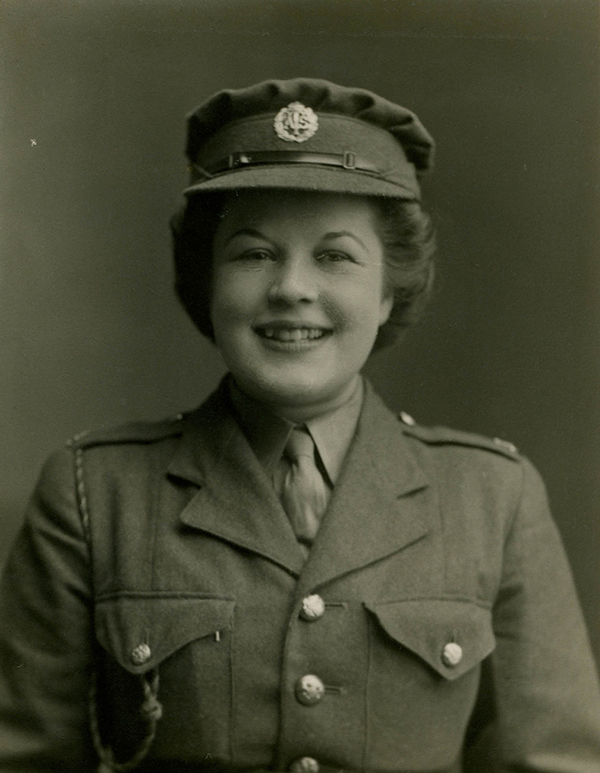
100 Years of Remembrance
Fort Rodd Hill and Fisgard Lighthouse National Historic Sites
Together, we will remember them.
100 years have passed since the end of the First World War. Today, the staff of Fort Rodd Hill National Historic Site want to share with you stories of people we remember. Over several months as part of an exhbit we call 100 Years of Remembrance, we uncovered the stories of our own ancestors and relatives who lived through times of war. Most families are full of narratives like these if we just take the time to ask and listen.
An emotional voyage
Through this project, Parks Canada staff have taken a remarkable journey of discovery. We all realized just how much war has impacted our loved ones, whose genes and memories we carry with us today. We wanted you to hear these stories through the individual voices of our staff, so that you might hear echoes of your own family stories. Below is a selection of those stories.
Visit Fort Rodd Hill and Fisgard Lighthouse National Historic Site and discover all 14 family stories on display in the Casemates 3 exhibit area.
Usher marries soldier after three dates
"It was while she was working at the movie theatre that she met my grandfather Harvey Stewart Bell, a soldier with the Canadian army"
by Michelle Holmes
(Site Manager)

100 Years of Remembrance
As I child I would sit with my Nana, Margaret Montgomery Hill Bell, as she would share her dream of returning to Scotland, to her home once again. She would tell me about how she was an usher in a movie theatre, of how her mother raised 5 kids with very little help or resources, how her father abandoned the family leaving them destitute, how she had a bomb shelter in her backyard. Education was very important to her family and she stayed in school until war broke out and she went to work in a factory, ripping tin foil off the back of cigarette papers to be used for ammunition.
It was while she was working at the movie theatre that she met my grandfather Harvey Stewart Bell, a soldier with the Canadian army, who was on a date with her sister. Apparently my Nana won his heart on the spot!On his next leave, he proposed, and on their third meeting, they were married. A terrified bride at 18 years old, barely knowing her new husband, my Nana made him sleep on a bedroom chair.
Harvey had been told by a hired farm labourer back in Canada to look up the Montgomery family if he ended up in Scotland. Later we discovered that this farm labourer was in fact my Nana’s father who had vanished years before.
They continued to get to know each other during his leaves, and when the war was over he returned to Canada. My Nana applied to the War Brides Bureau to come to Canada, and they wrote letters while they waited to see each other again. On April 28, 1946 Margaret sailed to Canada on the Lady Nelson, arriving at Peir 21 in Halifax. After a 2 day train ride to Toronto, she was at last reunited with Harvey.
Life in Ontario was incredibly challenging. While she believed she was coming to a large family farm, she wasn’t prepared for the lack of plumbing and electricity, and scores of other family members who shared the home. She was teased for her Scottish brogue and worked hard to adapt, eventually losing her accent – unless she was angry! She often lamented her days in Scotland and often fantasized about her return, even as I sat on her lap and listened to her stories. My Nana never made it back to Scotland, but I had the opportunity to travel with my mother to see her old stomping grounds, the house she grew up in, and of course, the theatre where it all began.
Usher marries soldier after three dates
"It was while she was working at the movie theatre that she met my grandfather Harvey Stewart Bell, a soldier with the Canadian army"

by Michelle Holmes
(Site Manager)
As I child I would sit with my Nana, Margaret Montgomery Hill Bell, as she would share her dream of returning to Scotland, to her home once again. She would tell me about how she was an usher in a movie theatre, of how her mother raised 5 kids with very little help or resources, how her father abandoned the family leaving them destitute, how she had a bomb shelter in her backyard. Education was very important to her family and she stayed in school until war broke out and she went to work in a factory, ripping tin foil off the back of cigarette papers to be used for ammunition.
It was while she was working at the movie theatre that she met my grandfather Harvey Stewart Bell, a soldier with the Canadian army, who was on a date with her sister. Apparently my Nana won his heart on the spot!On his next leave, he proposed, and on their third meeting, they were married. A terrified bride at 18 years old, barely knowing her new husband, my Nana made him sleep on a bedroom chair.
Harvey had been told by a hired farm labourer back in Canada to look up the Montgomery family if he ended up in Scotland. Later we discovered that this farm labourer was in fact my Nana’s father who had vanished years before.
They continued to get to know each other during his leaves, and when the war was over he returned to Canada. My Nana applied to the War Brides Bureau to come to Canada, and they wrote letters while they waited to see each other again. On April 28, 1946 Margaret sailed to Canada on the Lady Nelson, arriving at Peir 21 in Halifax. After a 2 day train ride to Toronto, she was at last reunited with Harvey.
Life in Ontario was incredibly challenging. While she believed she was coming to a large family farm, she wasn’t prepared for the lack of plumbing and electricity, and scores of other family members who shared the home. She was teased for her Scottish brogue and worked hard to adapt, eventually losing her accent – unless she was angry! She often lamented her days in Scotland and often fantasized about her return, even as I sat on her lap and listened to her stories. My Nana never made it back to Scotland, but I had the opportunity to travel with my mother to see her old stomping grounds, the house she grew up in, and of course, the theatre where it all began.
Strong roots remembered
"Any slave that abandoned their American master was promised freedom, land and rights by the British in exchange for their service."
by Susan Johnson (MacIsaac)
(Species at Risk Engagement Officer)

100 Years of Remembrance
My story of remembrance and service predates World War I. It begins with my Great Great Great Grandfather, Andrew Izzard who was a slave in South Carolina and escaped to Nova Scotia in 1783.
During the American Revolution (1775-1783), any slave that abandoned their American master was promised freedom, land and rights by the British in exchange for their service. Because they were loyal to Britain, they were called “Black Loyalists”. The Book of Negroes is a historical British document that recorded the names and descriptions of 3,000 Black Loyalists who escaped to British lines and were evacuated to Nova Scotia as free people of colour. My Great Great Great Grandfather was one of them. He received a freedom certificate signed by General Musgrave, and was signed to the Wagon Master General’s Department, which showed military service to the British. Andrew eventually settled in Guysborough, Nova Scotia where my Grandfather still lives today.
I am grateful for the strength, bravery, and resilience of my ancestors and know that these qualities are woven into the fabric of who I am. I gather my own strength knowing that I am a part of their legacy.
Strong roots remembered
"Any slave that abandoned their American master was promised freedom, land and rights by the British in exchange for their service."

by Susan Johnson (MacIsaac)
(Species at Risk Engagement Officer)
My story of remembrance and service predates World War I. It begins with my Great Great Great Grandfather, Andrew Izzard who was a slave in South Carolina and escaped to Nova Scotia in 1783.
During the American Revolution (1775-1783), any slave that abandoned their American master was promised freedom, land and rights by the British in exchange for their service. Because they were loyal to Britain, they were called “Black Loyalists”. The Book of Negroes is a historical British document that recorded the names and descriptions of 3,000 Black Loyalists who escaped to British lines and were evacuated to Nova Scotia as free people of colour. My Great Great Great Grandfather was one of them. He received a freedom certificate signed by General Musgrave, and was signed to the Wagon Master General’s Department, which showed military service to the British. Andrew eventually settled in Guysborough, Nova Scotia where my Grandfather still lives today.
I am grateful for the strength, bravery, and resilience of my ancestors and know that these qualities are woven into the fabric of who I am. I gather my own strength knowing that I am a part of their legacy.
In hopes for the right to vote
"Frank enlisted at 22-years-old... determined to prove his loyalty to a country that would not accept him."
by Zoe McCormack
(Interpreter)

100 Years of Remembrance
Frank Wong volunteered to serve in the Second World War for two reasons: One, his love of Canada, and two, in the hopes that serving might help Chinese-Canadians one day have the right to vote.
Despite being born in Canada to a family that had worked hard for generations to build a life in Vancouver, Frank had to fight against daily discrimination including not being allowed to vote and segregation in public spaces. And, despite being treated as a second class citizen, Frank enlisted at 22 years old and served in the Royal Canadian Ordinance Corps, determined to prove his loyalty to a country that would not accept him.
Frank’s role was to repair trucks and artillery, and keep the artillery supplied with shells. When the First Canadian Army moved through Europe after D-Day, the Ordinance Corps kept vehicles and weapons working in their moving repair shops as they travelled through France and the Netherlands. The deprivation of Dutch civilians struck Frank hard. He and other members of his unit gave away their rations to the hungry Dutch children before being caught by a superior who ordered them to stay fed for the battles ahead.
Frank was returning to his unit from a leave in Paris when the war officially ended. The celebrations in Europe were amazing. After his return to Canada, Frank and many other Chinese-Canadian veterans worked together in campaigning to have the right to vote. It was finally granted in 1947, although immigration from China was still heavily restricted until 1967, and Frank would say later in his life that his time in the military was the least discrimination he ever faced. Frank went on to found the Chinese Canadian Military Museum Society, which collected the stories of these often overlooked veterans and preserved an important part of Canadian history. He returned to the Netherlands in 2003 and presented with a medal for his participation in the liberation of the Netherlands.
Frank’s legacy of service and activism has carried on in his large family after his death in 2013.
In hopes for the right to vote
"Frank enlisted at 22-years-old... determined to prove his loyalty to a country that would not accept him."

by Zoe McCormack
(Interpreter)
Frank Wong volunteered to serve in the Second World War for two reasons: One, his love of Canada, and two, in the hopes that serving might help Chinese-Canadians one day have the right to vote.
Despite being born in Canada to a family that had worked hard for generations to build a life in Vancouver, Frank had to fight against daily discrimination including not being allowed to vote and segregation in public spaces. And, despite being treated as a second class citizen, Frank enlisted at 22 years old and served in the Royal Canadian Ordinance Corps, determined to prove his loyalty to a country that would not accept him.
Frank’s role was to repair trucks and artillery, and keep the artillery supplied with shells. When the First Canadian Army moved through Europe after D-Day, the Ordinance Corps kept vehicles and weapons working in their moving repair shops as they travelled through France and the Netherlands. The deprivation of Dutch civilians struck Frank hard. He and other members of his unit gave away their rations to the hungry Dutch children before being caught by a superior who ordered them to stay fed for the battles ahead.
Frank was returning to his unit from a leave in Paris when the war officially ended. The celebrations in Europe were amazing. After his return to Canada, Frank and many other Chinese-Canadian veterans worked together in campaigning to have the right to vote. It was finally granted in 1947, although immigration from China was still heavily restricted until 1967, and Frank would say later in his life that his time in the military was the least discrimination he ever faced. Frank went on to found the Chinese Canadian Military Museum Society, which collected the stories of these often overlooked veterans and preserved an important part of Canadian history. He returned to the Netherlands in 2003 and presented with a medal for his participation in the liberation of the Netherlands.
Frank’s legacy of service and activism has carried on in his large family after his death in 2013.
Seeking out culture amidst conflict
"It was an exciting time for a young woman who had never been away from the midlands before."
by Helen Davies
(Field Unit Superintendent)

100 Years of Remembrance
Margaret M. Davies (neé Heppenstall) was born in Dudley, West Midlands, England, in 1920.
Margaret, who was given the name of Bobbie by her army colleagues, enlisted in the Auxiliary Territorial Service (ATS) in Northampton, England, in 1940. The ATS, formed in 1938, was the women’s branch of the British Army during the Second World War.
Before enlisting, Bobbie had worked for a tea tester at a midlands tea company and as a “tracer” at a draughting company. Following military testing to assess her aptitude for various placements, it was determined that Bobbie was best be suited to the role of Morse code operator. Initially, this news was a bitter disappointment for her, as she had had her heart set on driving a big truck, or “lorry” as they are known in England. Unfortunately, at only 5’ ½” her feet didn’t reach the pedals!
However she came to love her role as a wireless operator, saying, “it was like learning another language,” and she was skilled in the work.
She was eventually posted to London, England, where she worked underground at the War Office, Whitehall. She was billeted in a beautiful stately home in Queen Anne’s Gate, Westminster, a far cry from her very modest, working class, upbringing on Buffery Road, Dudley. It was an exciting time for a young woman who had never been away from the midlands before.
After working hard, sometimes doing back-to-back shifts, when she was off duty, she would rush to a kiosk in Trafalgar Square to get tickets to the opera, ballet and theatre, all of which were free. She spoke about how thrilling it was to be exposed to the city culture and to meet people from around the country and from other parts of the world. It was an exhilarating time in her life and one she remembered decades later with great fondness.
Of course, it was also a time of personal and collective sorrow and sacrifice, brought home to her on Sunday, June 18th, 1944, when the Royal Military Chapel, St. James Park, known as the Guards Chapel at the Wellington Barracks, was bombed during the Blitz.
Bobbie had come off duty, having completed a midnight shift. When she got back to the billet she saw that she was down for church parade, which was at 11:00 am. She was so exhausted that she risked being put on a charge (i.e. punishment such as peeling potatoes or scrubbing the officer’s floor) and decided not to go to church that Sunday. She says that she was “disobedient and went to bed” instead. The next thing she remembers was being awakened two hours later by a large blast and glass on the floor from the shattered windows. Her billet was only a ten (10) minute march from Wellington Barracks. A V1 flying bomb, known colloquially as a “buzz bomb or doodlebug” had hit the chapel, killing 121 people and injuring 141 others.
Bobbie spoke about how the event was a very real reminder to her of the impact of war and the price that people paid, with their lives, serving their country.
Bobbie’s war service shaped who she became in her adult life. She met her future husband, Peter E.C. Davies, British Royal Signal Corps during her time with the ATS, having been assigned to train him in Morse code. After the War, she travelled with him to postings around the world, in Germany, Malta, Malaysia, and England, further exposing herself to a new sites, cultures and societies. She was a strong advocate for peace throughout her life, saying that she’d “do anything, anything in the world to bring peace and get people to talk instead of fight.”
(Drawn in part from, www.thememoryproject.com)
Seeking out culture amidst conflict
"It was an exciting time for a young woman who had never been away from the midlands before."

by Helen Davies
(Field Unit Superintendent)
Margaret M. Davies (neé Heppenstall) was born in Dudley, West Midlands, England, in 1920.
Margaret, who was given the name of Bobbie by her army colleagues, enlisted in the Auxiliary Territorial Service (ATS) in Northampton, England, in 1940. The ATS, formed in 1938, was the women’s branch of the British Army during the Second World War.
Before enlisting, Bobbie had worked for a tea tester at a midlands tea company and as a “tracer” at a draughting company. Following military testing to assess her aptitude for various placements, it was determined that Bobbie was best be suited to the role of Morse code operator. Initially, this news was a bitter disappointment for her, as she had had her heart set on driving a big truck, or “lorry” as they are known in England. Unfortunately, at only 5’ ½” her feet didn’t reach the pedals!
However she came to love her role as a wireless operator, saying, “it was like learning another language,” and she was skilled in the work.
She was eventually posted to London, England, where she worked underground at the War Office, Whitehall. She was billeted in a beautiful stately home in Queen Anne’s Gate, Westminster, a far cry from her very modest, working class, upbringing on Buffery Road, Dudley. It was an exciting time for a young woman who had never been away from the midlands before.
After working hard, sometimes doing back-to-back shifts, when she was off duty, she would rush to a kiosk in Trafalgar Square to get tickets to the opera, ballet and theatre, all of which were free. She spoke about how thrilling it was to be exposed to the city culture and to meet people from around the country and from other parts of the world. It was an exhilarating time in her life and one she remembered decades later with great fondness.
Of course, it was also a time of personal and collective sorrow and sacrifice, brought home to her on Sunday, June 18th, 1944, when the Royal Military Chapel, St. James Park, known as the Guards Chapel at the Wellington Barracks, was bombed during the Blitz.
Bobbie had come off duty, having completed a midnight shift. When she got back to the billet she saw that she was down for church parade, which was at 11:00 am. She was so exhausted that she risked being put on a charge (i.e. punishment such as peeling potatoes or scrubbing the officer’s floor) and decided not to go to church that Sunday. She says that she was “disobedient and went to bed” instead. The next thing she remembers was being awakened two hours later by a large blast and glass on the floor from the shattered windows. Her billet was only a ten (10) minute march from Wellington Barracks. A V1 flying bomb, known colloquially as a “buzz bomb or doodlebug” had hit the chapel, killing 121 people and injuring 141 others.
Bobbie spoke about how the event was a very real reminder to her of the impact of war and the price that people paid, with their lives, serving their country.
Bobbie’s war service shaped who she became in her adult life. She met her future husband, Peter E.C. Davies, British Royal Signal Corps during her time with the ATS, having been assigned to train him in Morse code. After the War, she travelled with him to postings around the world, in Germany, Malta, Malaysia, and England, further exposing herself to a new sites, cultures and societies. She was a strong advocate for peace throughout her life, saying that she’d “do anything, anything in the world to bring peace and get people to talk instead of fight.”
(Drawn in part from, www.thememoryproject.com)
- Date modified :